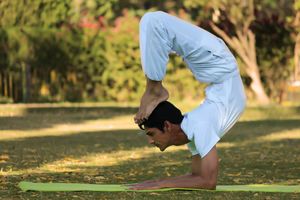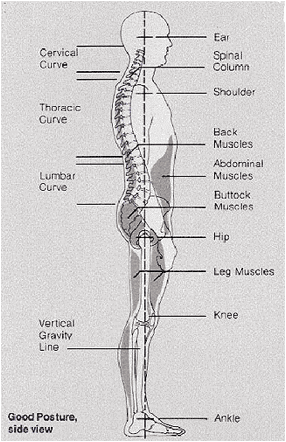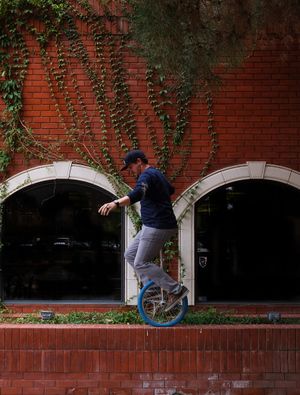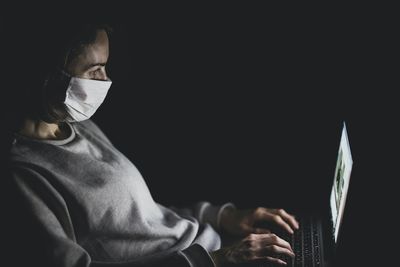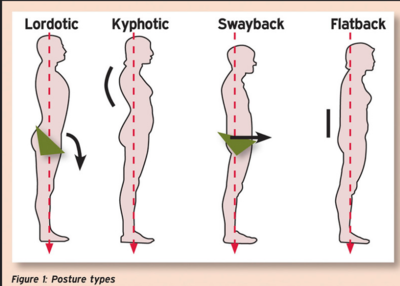Posture
One Page Owner - Usha as part of the One Page Project
Introduction [edit | edit source]
Good posture is about more than standing up straight so you can look your best.
- It is an important part of your long-term health.
- Making sure that you hold your body the right way, whether you are moving or still, can prevent pain, injuries, and other health problems.
What is posture?
Posture is defined as the attitude assumed by the body either with support during the course of muscular activity, or as a result of the coordinated action performed by a group of muscles working to maintain the stability. There are two types[1]:
- Dynamic posture is how you hold yourself when you are moving, like when you are walking, running, or bending over to pick up something. It is usually required to form an efficient basis for movement. Muscles and non-contractile structures have to work to adapt to changing circumstances.[2]
- Static posture is how you hold yourself when you are not moving, like when you are sitting, standing, or sleeping. Body segments are aligned and maintained in fixed positions. This is usually achieved by co-ordination and interaction of various muscle groups which are working statically to counteract gravity and other forces.[3]
It is important to make sure that you have good dynamic and static posture[4].
Posture Assessment[edit | edit source]
The key to good posture is the position of the spine. The spine has three natural curves - at your neck, mid/upper back, and lower back. Correct posture should maintain these curves, but not increase them. Your head should be above your shoulders, and the top of your shoulder should be over the hips.
- In an ideal posture, the line of gravity should pass through specific points of the body. This can simply be observed or evaluated using a plumb line to assess the midline of the body.
- This line should pass through the lobe of the ear, the shoulder joint, the hip joint, though the greater trochanter of the femur, then slightly anterior to the midline of the knee joint and lastly anterior to the lateral malleolus.
- When viewed from either the front or the back, the vertical line passing through the body's centre of gravity should theoretically bisect the body into two equal halves, with the bodyweight distributed evenly between the two feet.
While assessing posture, symmetry and rotations/tilts should be observed in the anterior, lateral and posterior views. Assess:
- Head alignment
- Cervical, thoracic and lumbar curvature
- Shoulder level symmetry
- Pelvic symmetry
- Hip, knee and ankle joints
In sitting:
- The ears should be aligned with the shoulders and the shoulders aligned with the hips
- The shoulders should be relaxed and elbows are close to the sides of the body
- The angle of the elbows, hips and knees is approximately 90 degrees
- The feet flat on the floor
- The forearms are parallel to the floor with wrists straight
- Feet should rest comfortably on a surface
Posture and Health[edit | edit source]
Poor posture can be bad for your health. Slouching (see image at R) or slumping over can
- Misalign your musculoskeletal system
- Increase pressure on the spine, making it more prone to injury and degeneration
- Cause neck, shoulder, and back pain
- Decrease flexibility
- Affect how well joints move
- Affect balance and increase risk of falling
- Make it harder to digest food
- Make it harder to breathe[4]
- The Relationship Between Posture and Pain[5][6][7][8] There are many theories that bad posture is a contributing factor in low back pain, some studies have shown that improved posture and postural control can have a positive effect on pain.
Physiotherapy[edit | edit source]
Education, teach client to:
- Be mindful of posture during everyday activities, like watching television, washing dishes, or walking
- Stay active. Any kind of exercise may help improve your posture, but certain types of exercises can be especially helpful. eg. yoga, tai chi, and other classes that focuses on body awareness. It is also a good idea to do exercises that strengthen your core.
- Maintain a healthy weight. Extra weight can weaken abdominal muscles, cause problems for pelvis and spine, and contribute to low back pain.
- Wear comfortable, low-heeled shoes. High heels, for example, can throw off balance and force person to walk differently. This puts more stress on muscles and harms posture.
- Make sure work surfaces are at a comfortable height for you, whether sitting in front of a computer, making dinner, or eating a meal[4].
Physiotherapist can identify posture style and provide hands-on treatment, posture correction exercises and helpful home products for you to achieve great posture. Some of objectives are listed below:
- Obtain Normal Joint Range of Motion. Necessary to allow you achieve good posture alignment. eg Thoracic Manual Therapy.
- Obtain Normal Muscle Length. If muscles too tight client will be unable to attain a normal posture.
- Obtain Good Muscle Strength. To be able to pull clients body into the correct posture.
- Obtain Excellent Muscle Endurance. Postural muscles need to able to work for hours on end. Poor endurance is a major factor in habitual poor posture.
- Normal Nerve Extensibility. Neural tissue needs enough length to allow for normal posture.
- Good Spatial Awareness. ie where you are in space. Provide with verbal and visual feedback and assist with postural taping.
- Perfect Posture Habits. The hardest part is the initial change, then reinforcing the correct habit.[9]
Muscle Action in Posture[edit | edit source]
The balanced posture of the body reduces the work done by the muscles in maintaining it in an erect posture. It has been determined (using electromyography) that, in general[10]:
- The intrinsic muscles of the feet are quiescent, because of the support provided by the ligaments.
- Soleus is constantly active because gravity tends to pull the body forward over the feet. Gastrocnemius and the deep posterior tibial muscles are less frequently active.
- Tibialis anterior is less active (unless high heels are being worn).
- Quadriceps and the Hamstrings are generally not as active[11].
- Iliopsoas is constantly active.
- Gluteus maximus is inactive.
- Gluteus medius and tensor fascia latae are active to counteract lateral postural sway.
- Erector Spinae is active, counteracting gravity's pull forwards.
- The abdominal muscles remain quiescent, although the lower fibres of the Internal obliques are active in order to protect the inguinal canal
Examples of Types of Standing Posture[edit | edit source]
Some of the examples of faulty posture can be as follows:
- Lordotic posture- Lordosis refers to the normal inward curvature of the spine. When this curve is exaggerated it is usually referred to as hyperlordosis. The pelvis is usually tilted anteriorly.
- Sway Back Posture- In this type of posture, there is forward head, hyper-extension of the cervical spine, flexion of the thoracic spine, lumbar spine extension, posterior tilt of the pelvis, hip and knee hyper-extension and ankle slightly plantarflexed.
- Flat back posture- In this type of posture, there is forward head, extension of the cervical spine, extension of the thoracic spine, loss of lumbar lordosis and posterior pelvic tilt.
- Forward head posture - Describes the shift of the head forward with the chin poking out. It is caused by increased flexion of the lower cervical spine and upper thoracic spine with increased extension of the upper cervical spine and extension of the occiput on C1.
- Scoliosis - A deviation of the normal vertical line of the spine, consisting of a lateral curvature and rotation of the vertebrae. Scoliosis is considered when there is at least 10° of spinal angulation on the posterior-anterior radiograph associated with vertebral rotation[12]. This is a 3 dimensional C or S shaped sideways curve of the spine.
- Kyphosis - An increased convex curve observed in the thoracic or sacral regions of the spine.
Final Remarks[edit | edit source]
- It is important to make sure clients have good dynamic and static posture.
- Just knowing how to correct posture is not enough to achieve a change actual habit.
- Bodies uses learnt motor patterns to perform everyday activities. When we sit, stand, walk or move - our body follows previously learnt motor patterns. If your body has learned to slouch - that's what it will do.
- Physiotherapists via correcting and improving posture through assessment and treatment techniques can lead to many positive health outcomes. for clients.
References[edit | edit source]
- ↑ Gardiner MD. The principles of exercise therapy. Bell; 1957.
- ↑ Levangie PK, Norkin CC. Joint structure and function: a comprehensive analysis. FA Davis; 2011 Mar 9.
- ↑ Howorth MB. Posture in adolescents and adults. The American journal of nursing. 1956 Jan 1:34-6.
- ↑ 4.0 4.1 4.2 Medlineplus Good Posture Available from:https://medlineplus.gov/guidetogoodposture.html (last accessed 21.4.2020)
- ↑ Balague F, Troussier B, Salminen JJ. Non-specific low back pain in children and adolescents: risk factors. Eur Spine J 1999: 6: 429–438
- ↑ Widhe T. Spine: posture, mobility and pain. A longitudinal study from childhood to adolescence. European Spine Journal. 2001 Apr 1;10(2):118-23.
- ↑ Knight JF, Baber C. Neck muscle activity and perceived pain and discomfort due to variations of head load and posture. Aviation, space, and environmental medicine. 2004 Feb 1;75(2):123-31.
- ↑ Laird RA, Kent P, Keating JL. Modifying patterns of movement in people with low back pain -does it help? A systematic review. BMC Musculoskelet Disord. 2012;13:169.
- ↑ Physioworks Posture Correction Available from:https://physioworks.com.au/treatments-1/posture-correction (last accessed 21.4.2020)
- ↑ Chiba R, Takakusaki K, Ota J, Yozu A, Haga N. Human upright posture control models based on multisensory inputs; in fast and slow dynamics. Neuroscience research. 2016 Mar 1;104:96-104.
- ↑ Tikkanen O, Haakana P, Pesola AJ, Häkkinen K, Rantalainen T, Havu M, Pullinen T, Finni T. Muscle activity and inactivity periods during normal daily life. PloS one. 2013;8(1).
- ↑ Janicki JA, Alman B. Scoliosis: Review of diagnosis and treatment. Paediatr Child Health. 2007 Nov: 12(9): 771-776.
